#220 BCE
Explore tagged Tumblr posts
Photo

Barberini Faun, 220 BCE
Glyptothek, Munich
#barberini faun#glyptothek museum#glyptothek#munich#germany#europe#travel#travelling#museum#gallery#art#art history#220 bce#bce#my photos
15 notes
·
View notes
Text
1 note
·
View note
Text
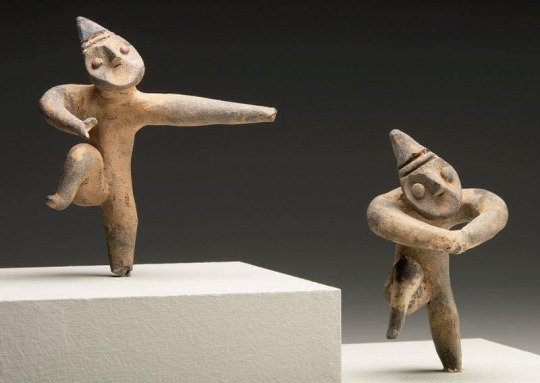
Ceramic dancing figures from China. 206 BCE-220 CE, now housed at the Minneapolis Institute of Art
More: https://thetravelbible.com/museum-of-artifacts/
3K notes
·
View notes
Text
Yin and Yang



It's always occured to me that Miraculous Ladybug is based on Yin and Yang philosophy but at the same time it's really not.
Both the symbol of the black cat and the ladybug acquired their meanings around the same time in medieval Europe. Superstitions about black cats originated during the period of witch hunts, which began in the early 13th century in Europe.The name "ladybug" comes from medieval European farmers who would pray to the Virgin Mary for good harvests. Ladybugs feed on pests that destroy crops, so their appearance was seen as a sign that their prayers had been answered.
However, Yin and Yang philosophy came from ancient China and this concept has its own symbols.
There're no records about this concept being used by ancient Chinese alchemists. However, the concepts of essences is a part of Neidan branch of alchemy, whereas experimenting with minerals and something material is a part of Waidan alchemy. So, miraculouses might be the result of combination of two of these branches.
First notice of Waidan alchemy was made during Han Dynasty (206 BCE–220 CE) and gradually declined until the Ming dynasty (1368–1644). Neidan was arguably first mentioned in in Jin dynasty (266-420). Also Ying and Yan philosophy was first mention in the 16 century. So, creation of the miraculouses should have taken place between the 16 century and the 17 century.
Dragon as the symbol of Yang, the Sun and it is connected with masculine energy, so this is considered to be a miraculous for males.
Tiger as the symbol of Yin, the Moon, on the contrary, is considered to be a miraculous for females.
Both of them are in the beginning of their way for Balance. Marinette will go through Red Dragon phase before becoming Golden Dragon. While Adrien will go through Black Tiger phase before becoming Golden Tiger.

But I.. couldn't come up with their names
#Dragon and Tiger AU#art#artists on tumblr#artwork#my art#digital art#mlb fanart#mlb#mlb fandom#mlb au#miraculous#miraculous lb#miraculous fanart#miraculous ladybug#miraculous au#adrien agreste#mlb adrien#mlb marinette#marinette dupain cheng#Au info
276 notes
·
View notes
Text
"In historical context though-"
This book has potatoes and chilis in supply and demand when these were not traded until the late 15th century... and not used for cuisine and a foods crop cultivator in China well into the 17th and 18th century almost 200 years later. Folding fans that are seen abundantly were not popularized until the 13th century. Taoism was at its largest during the Warring States period of 450 BCE–c. 300 BCE with the epigram of Tao Te Ching. Confucianism became the abundant practice as of 206 BCE to 220 BCE with the authoring of The Analects. It uses fabricated province names for real world Chinese provinces that are relegated to a simple five, when there are of 22 (claimed) and have been the most stable to survive since the Yuan dynasty 1271-1368. Idioms used vary through the centuries and are still a staple of modern day vernacular. The version of futou Jin Guangyao alone wears was a wushamao (乌纱帽), used in the Ming dynasty 1368-1398. Futou was made a part of ministerial and court attire during the reign of Emperor Wu 560 BCE.
The author has said it has no standing Imperial Dynasty it takes place in and has borrowed aesthetics from the Han, Wei-Jin, Song, Tang, Ming and even Qing. All of which had seen several turns of dynasty from Han to Mongol to Han divine rulings. So no, there is no historical context to take in regard when it comes to Madam Yu's overt abuse, to Jiang Cheng's abuse, the clan's classisms and hypocrisy.
It was written in an alternate fantasy of China without this context of real world history and through the lens of modernity of its author. Do not use a history that does not pertain to a novel that is not has not and was never called historical.
128 notes
·
View notes
Text

Fooduary Day 10: Dragon's Beard Candy
Happy Lunar New Year!!! This one probably doesn’t seem very obvious but a white-candy version would be terribly unlucky!! (And I need all the luck I can get). So I tried to make the lantern slightly reminiscent of the treat while the character is styled in Han Dynasty fashion. According to the legend-history of dragon’s beard candy it was invented in the Han Dynasty (202 BCE 220 CE) which makes it our oldest dessert yet! And yeah, I went off script for this one. Day 10 was supposed to be Cinnamon rolls but I’m moving some stuff around because I so rarely get the chance to post something to celebrate.
I am the artist! Do not post without permission & credit! Thank you! Come visit me over on: instagram, tiktok or check out my coloring book available now \ („�� ֊ •„) /
https://linktr.ee/ellen.artistic
#dragon's beard candy#han dynasty clothing#fooduary#art challenge#historical fashion#ellenart#lnart#character design#digital illustration#historically inspired#fooduary2024#dragons beard#hanfu#happy CNY#happy lunar new year#year of the dragon#chinese new year
369 notes
·
View notes
Text

My revamp of the sculpture, Sleeping Satyr / Barberini Faun, by Unknown Artist, circa 220 BCE
#astrazero#gaygoth#gaywitch#gayartist#darkart#gayart#queerartist#vampire#astra zero#darkartists#gay historical inspired art#gay historical art
344 notes
·
View notes
Photo

Ancient Chinese Warfare
In ancient China warfare was a means for one region to gain ascendancy over another, for the state to expand and protect its frontiers, and for usurpers to replace an existing dynasty of rulers. With armies consisting of tens of thousands of soldiers in the first millennium BCE and then hundreds of thousands in the first millennium CE, warfare became more technologically advanced and ever more destructive. Chariots gave way to cavalry, bows to crossbows and, eventually, artillery stones to gunpowder bombs. The Chinese intelligentsia may have frowned upon warfare and those who engaged in it and there were notable periods of relative peace but, as in most other ancient societies, for ordinary people it was difficult to escape the insatiable demands of war: either fight or die, be conscripted or enslaved, win somebody else's possessions or lose all of one's own.
Attitudes to Warfare
The Chinese bronze age saw a great deal of military competition between city-rulers eager to grab the riches of their neighbours, and there is no doubt that success in this endeavour legitimised reigns and increased the welfare of the victors and their people. Those who did not fight had their possessions taken, their dwellings destroyed and were usually either enslaved or killed. Indeed, much of China's history thereafter involves wars between one state or another but it is also true that warfare was perhaps a little less glorified in ancient China than it was in other ancient societies.
The absence of a glorification of war in China was largely due to the Confucian philosophy and its accompanying literature which stressed the importance of other matters of civil life. Military treatises were written but, otherwise, stirring tales of derring-do in battle and martial themes, in general, are all rarer in Chinese mythology, literature and art than in contemporary western cultures, for example. Even such famous works as Sun-Tzu's The Art of War (5th century BCE) warned that, "No country has ever profited from protracted warfare” (Sawyer, 2007, 159). Generals and ambitious officers studied and memorised the literature on how to win at war but starting from the very top with the emperor, warfare was very often a policy of last resort. The Han Dynasty (206 BCE - 220 CE) was notable for its expansion, as were some Tang Dynasty emperors (618-907 CE) but, in the main, a strategy of paying off neighbours with vast tributes of silver and silk, along with a parallel exportation of “civilising” culture was seen as the best way to defend imperial China's borders. Then, if war ultimately proved unavoidable, it was better to recruit foreign troops to get on with it.
Joining the intellectuals with their disapproval of warfare were also the bureaucrats who had no time for uncultured military men. No doubt, too, the vast majority of the Chinese peasantry were never that keen on war either for it was they who had to endure conscription, heavy taxes in kind to pay for costly campaigns, and have their farms invaded and plundered.
With the emperors, the landed gentry, intellectuals and farmers all well-aware of what they could lose in war, it was, then, somewhat disappointing for them all that China, in any case, had just as many conflicts as anywhere else in the world in certain periods. One cannot ignore the common presence of fortifications in the bronze age, such chaotic centuries as the Autumn and Spring Period (722-481 BCE) with its one hundred plus rival states, the Warring States Period (481-221 BCE) with its incredible 358 separate conflicts or the fall of the Han when war was once again incessant between rival Chinese states. Northern steppe tribes were also constantly prodding and poking at China's borders and emperors were not averse to the odd foreign folly such as attacking ancient Korea.
Continue reading...
60 notes
·
View notes
Text
April 14, Xi'an, China, Shaanxi History Museum, Qin and Han Dynasties Branch (Part 1 - Political Structure, Laws, and Military):
This was the final museum I went to while in Xi'an, and despite its name, it is not the Shaanxi History Museum/陕西历史博物馆. It is a new branch that's in a separate location from the main museum, so it's also referred to as the "Qin/Han Branch"/秦汉馆 (ugh I wish I could've gone to the main branch), and the museum building and its gates were supposed to imitate the look of Qin/Han-era palaces. It was raining cats and dogs the night before, so the ground still bear traces of that. I had fun though.

This museum doesn't have a lot of unique artifacts that other museums don't have, but instead focuses on the political structure, thought, life, and technologies from Qin and Han dynasties, so there were a lot of tables, maps, and diagrams in the museum. I will only be giving a brief summary of each thing here so these posts won't get too long (and take too much effort to make). If you understand Chinese though, these may be helpful worldbuilding references.
First is a rough timeline of the history Qin dynasty (221 - 207 BC) to Han dynasty (202 BC - 220 AD) (right side of timeline) and how it fits within the overall ancient world history (left side of timeline) in the same time frame, just as a general reference so museum visitors can have an idea of when these dynasties and events took place. The timeline included events starting from when Qin was still a state (Warring States period, 476 - 221 BC) until after the end of Han dynasty (Three Kingdoms period, 220 - 280 AD; and Western Jin dynasty, 265 - 317 AD). Here, 公元元年 means 1 CE/AD, so 公元前 means BCE/BC, and 公元 means CE/AD. Also I know the left side is hard to read, sorry about that, it was easier to read in person. There is a key at the bottom though:
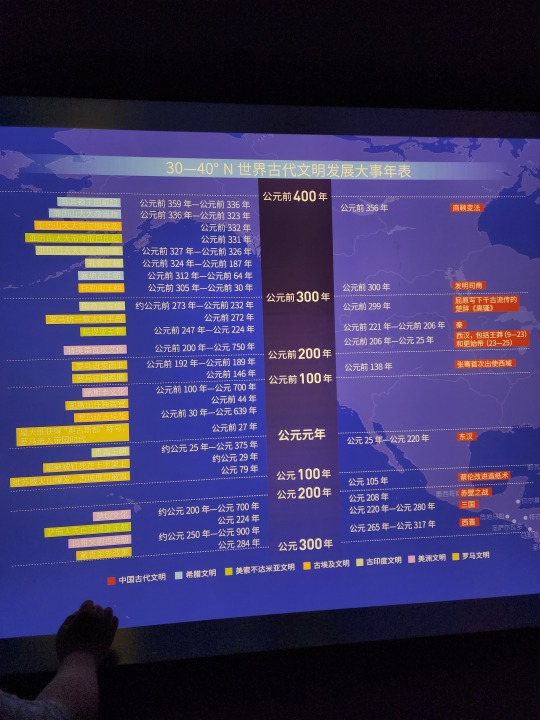
A diagram of the Three Lords and Nine Ministers system (三公九卿制) that was used as the central political structure of ancient China during Qin and Han dynasties, which was replaced by the Three Departments and Six Ministries system (三省六部制) in Sui dynasty (581 - 618 AD). There are many translations for the same positions, here I used what I think fits best for each position.
The Three Lords/三公 are (left to right on chart) : the Imperial Secretary/御史大夫 (handles the audit system and helps the chancellor), the Chancellor/丞相 (helps emperor handle national political affairs), and the Grand Commandant/太尉 (helps emperor handle military affairs).
The Nine Ministers/九卿 are (left to right): the Minister of Finance/治粟内史 (oversees public finance and tax system), the Minister of the Imperial Clan/宗正 (handles affairs within imperial clan), the Grand Herald/典客 (handles foreign policy), the Minister of the Guards/卫尉 (controls imperial guards), the Minister of Justice/廷尉 (oversees judicial system), the Minister of Attendants/郎中令 (controls palace guards, oversees imperial household, serves as imperial advisor, etc.), the Minister Coachman/太仆 (oversees the care, training, use, and purchase of horses; horses were an important resource in ancient times), the Lesser Treasurer/少府 (oversees the emperor's personal finances and some taxes), and the Minister of Ceremonies/奉常 (handles official ceremonies, worship, and rituals, oversees court astrologers and court scribes/historians).
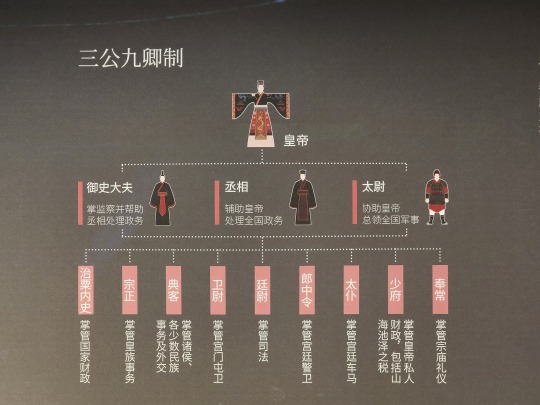
Qin and Han dynasty bureacratic systems. Right is Qin dynasty's system of commanderies/郡, counties/县, townships/乡, and villages/里 (levels of local government from highest to lowest). Left is Han dynasty's central government system, which designated the Three Lords and Nine Ministers system as the Outer Court/外朝 (executes policies), and added a Central Court/中朝 (decides policies).
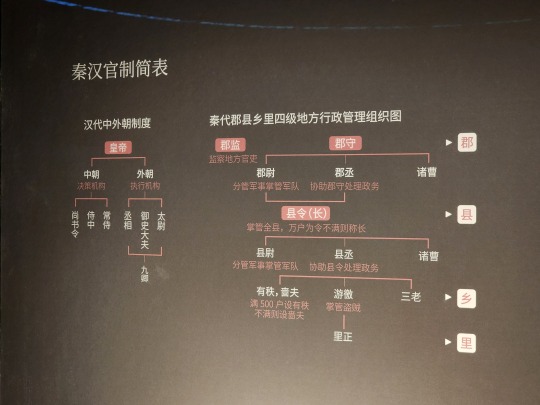
A list of the 48 commanderies during Qin dynasty and their locations today, grouped by where they were located before Qin dynasty (for example 7 of these groups were states during the Warring States period). A few of the names of these commanderies continue to be place names today, and some others often make appearances in modern novels.

The Recommendatory System/察举制 of Han dynasty, which was how officials were selected. Basically this process consists of a few steps: first the emperor would set what categories of talents are needed, then local government would recommend people to the central government accordingly. The emperor would ask the recommendees how they would deal with current issues, and then gave them positions based on how good their policy ideas were. Ideally the local officials would be impartial with recommendations, but in reality the local officials often belonged to powerful local clans, so these recommendations gradually became a way for the powerful clans to stay in power. This system was replaced by the Imperial Examination System/科举制 in later dynasties, which put more emphasis on exams as a way to select talents.


The locations of Qin and Han dynasty national temples, sacred mountains, and sacred bodies of water on a modern map. Of these, the temples marked in yellow were the temples dedicated to eight deities worshipped by the state of Qi, so they are collectively called the Eight Deities of Qi/齐地八神. Although the state of Qin eventually defeated the state of Qi, worship of these deities continued through Qin dynasty into Han dynasty. The temples marked in red were dedicated to deities worshipped by the state of Qin. The temples marked in purple were temples built in Han dynasty. The sacred waters are marked with wavy lines. The sacred mountains are marked in light blue-gray (a few are outside of this picture). MDZS fans may recognize Qishan/��山 on this map, and Three Kingdoms enthusiasts may recognize jieshishan/碣石山 as the place Cao Cao visited when he wrote the line "东临碣石,以观沧海" in his famous poem.
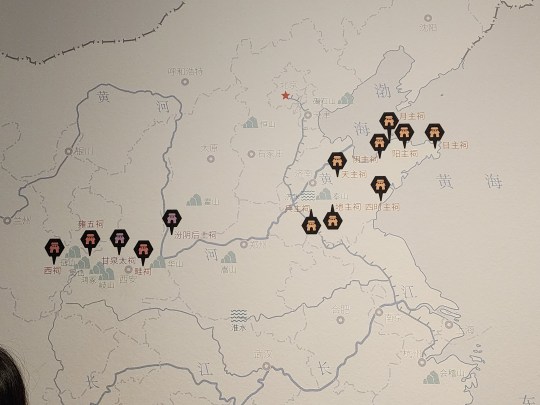
Replicas of a small part of the Qin-era bamboo texts found in a tomb of a Qin dynasty official at Shuihudi (睡虎地秦简). The originals are at Hubei Provincial Museum/湖北省博物馆. Many of these texts concern laws and decrees of Qin dynasty, and in another tomb in the same area there were also the oldest letters ever found in China (link goes to the full digitized text). These bamboo slips are meant to read from top to bottom, right to left, and the construction of bamboo scrolls are actually the very reason why Chinese texts read this way traditionally even on printed texts during later dynasties.
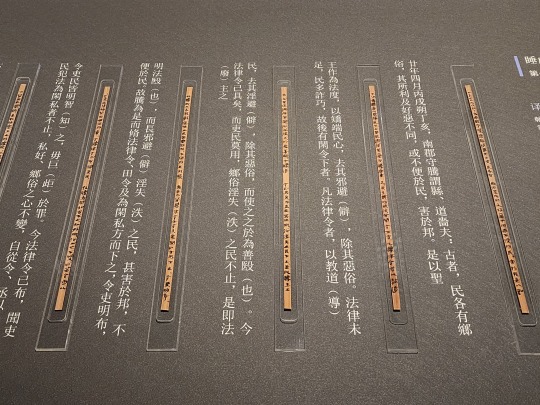
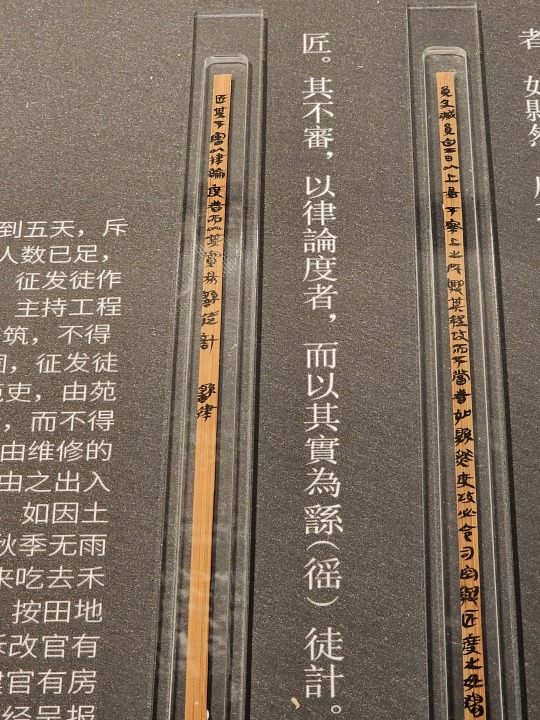
This was something I'd written about in the MDZS posts a few years ago, and now I've finally seen the real thing with my own eyes: the Tiger Tally/虎符 (I translated it as "Tiger Amulet" in that post but in fact "Tally" is the correct translation). Tiger tallys have two halves, each with gilded gold text upon them. This particular artifact is the left half of a tiger tally from late Warring States period (state of Qin), and reads:
"This is a tally of the armed forces, right half goes to the ruler of Qin, left half goes to (the official of) Du county. When the need to dispatch armored troops of over 50 soldiers arises, this half must find the other half held by the ruler in order to authorize this military activity. In case of emergency, there is no need to wait for this authorization." (“兵甲之符,右才君,左才杜。凡兴士披甲用兵五十人以上,必会君符,乃敢行之。燔燧之事,虽毋会符,行殹。”)
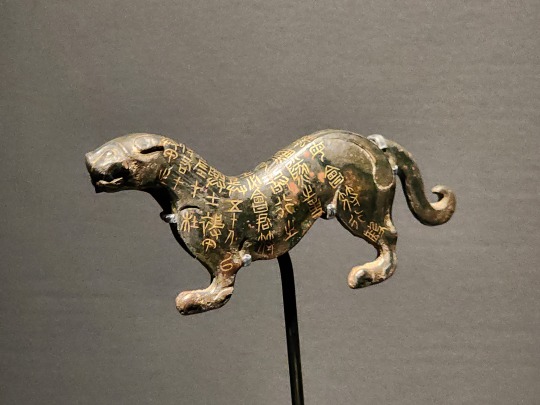
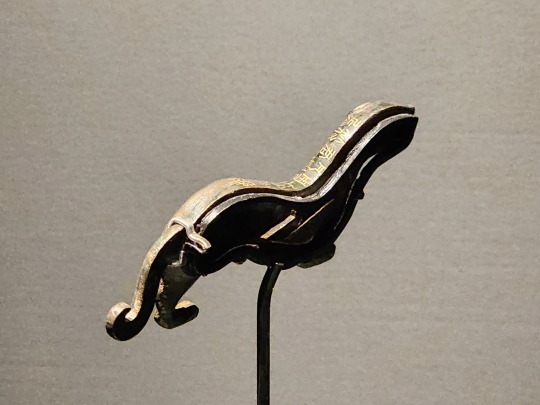
The different currencies (coins) of the states of Warring States period:
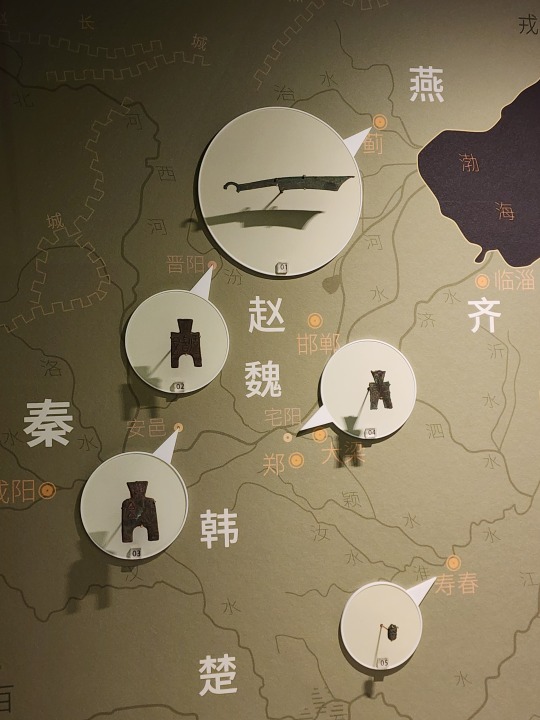
The different coins and coin molds during Qin and Han dynasties:
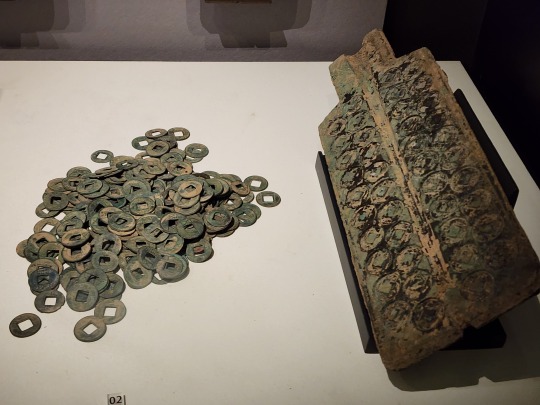
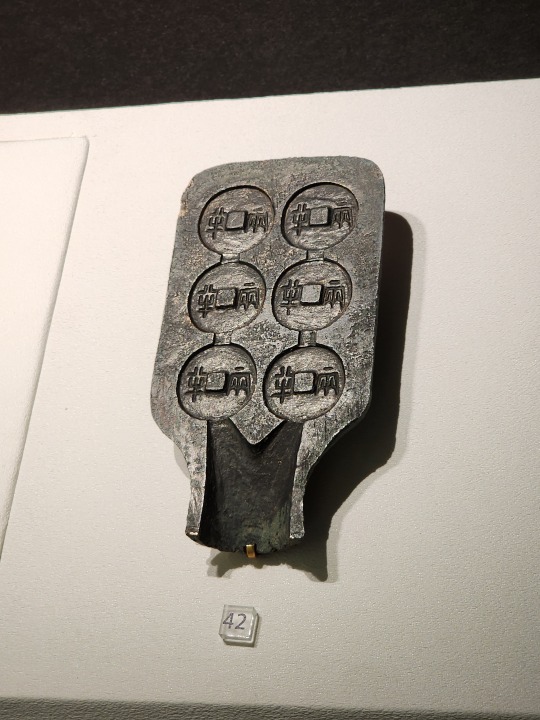
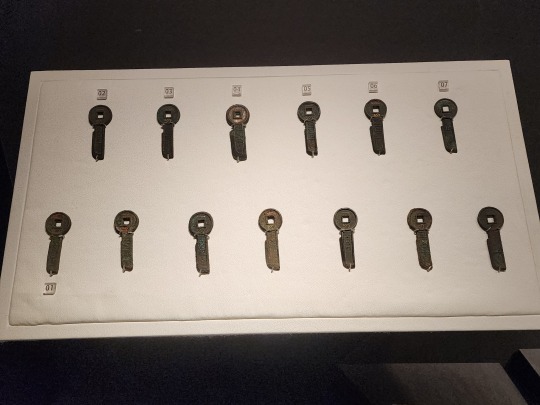
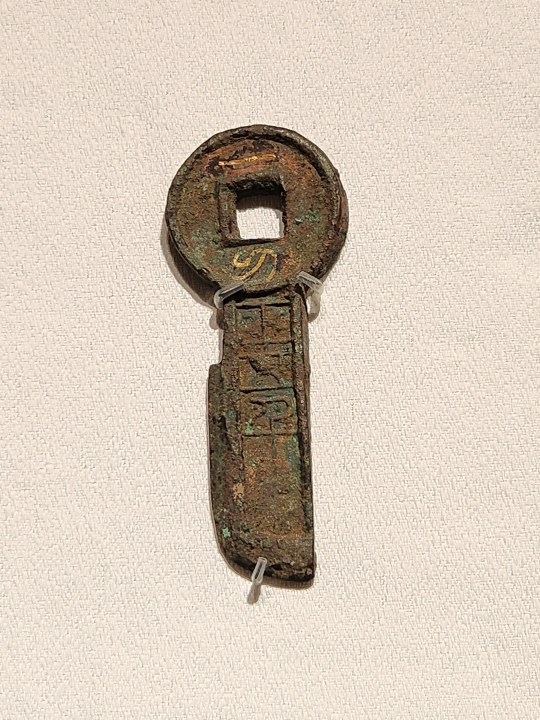
Left: Han dynasty disk-shaped gold ingots; these were rare currencies at the time and were mainly exchanged between the imperial family and nobility as gifts. Right: a standard weight from Qin dynasty that reads "weighs 30 jin/斤". Since Qin dynasty unified systems of measurements, and this weight is known to weigh 7.5 kg, we can easily convert the Qin-era jin to the modern kg (1 Qin-era jin = 0.25 kg).
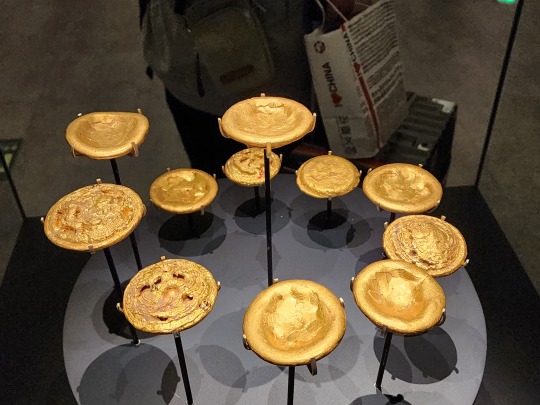
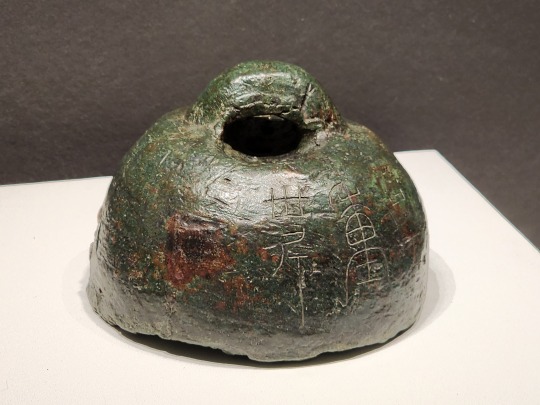
Terra cotta soldier and horse from Qin Shihuang's mausoleum. As some people have pointed out, these terra cotta soldiers were fully painted and colorful when they were first excavated, but when exposed to air, the paint quickly peeled and the colors faded, leaving the sculptures in their familiar clay-color. Few of these sculptures still have their original colors intact, thanks to preservation efforts. The immense difficulty of preservation is also a reason why modern Chinese archaeology has that rule of "don't excavate unless absolutely necessary".
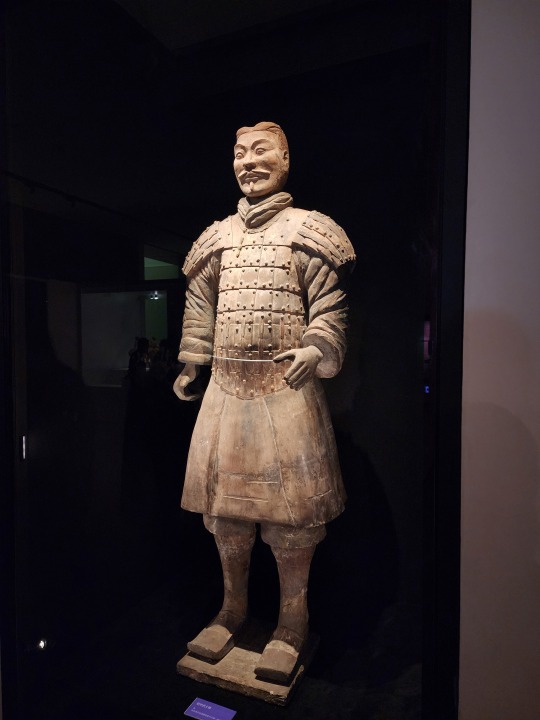
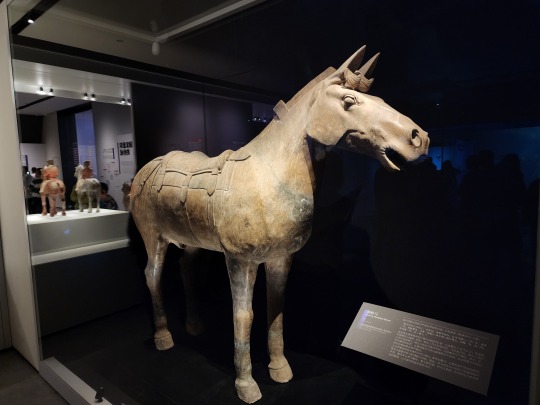
A Qin-era bronze jian/剑 (double-edged straight sword) from Qin Shihuang's mausoleum:

Left: Qin-era bronze spear heads and a pi/铍 head (on the right; pi is a type of ancient Chinese polearm). Right: Han-era ring-pommel dao/环首刀 (dao is a single-edged sword that can be straight or curved; interestingly, many ring-pommel dao artifacts exhibit a forward curve). Ring-pommel dao continued to be used in the military after Han dynasty.
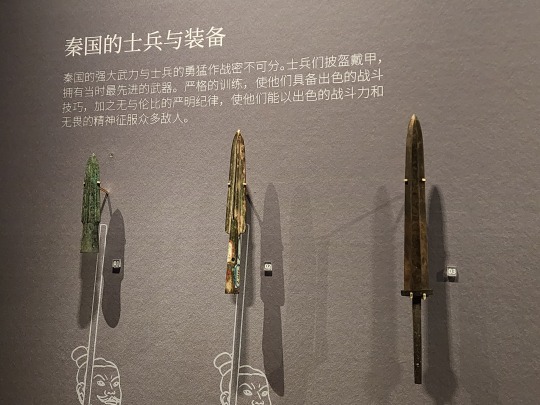
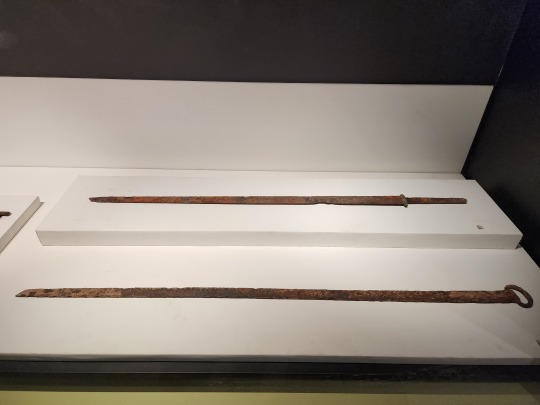
A suit of armor made out of stone from Qin Shihuang's mausoleum. These armor sets weigh about 18 kg or 39.7 lbs each, which is........actually not too bad. There are specialized armor sets in later dynasties that can weigh 30 kg or 66 lbs.
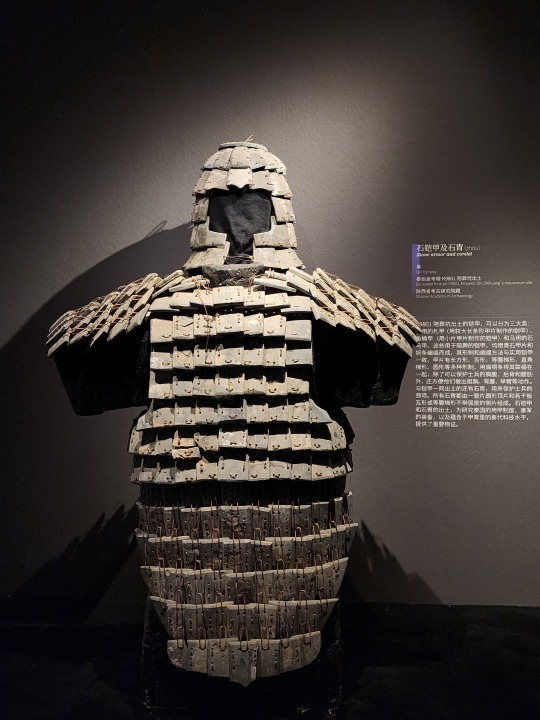
#2024 china#xi'an#china#shaanxi history museum qin and han dynasties branch#chinese history#qin dynasty#han dynasty#warring states period#three kingdoms#history#archaeology#mdzs
79 notes
·
View notes
Text
PSA - Don't Treat JTTW As Modern Fiction
This is a public service announcement reminding JTTW fans to not treat the work as modern fiction. The novel was not the product of a singular author; instead, it's the culmination of a centuries-old story cycle informed by history, folklore, and religious mythology. It's important to remember this when discussing events from the standard 1592 narrative.
Case in point is the battle between Sun Wukong and Erlang. A friend of a friend claims with all their heart that the Monkey King would win in a one-on-one battle. They cite the fact that Erlang requires help from other Buddho-Daoist deities to finish the job. But this ignores the religious history underlying the conflict. I explained the following to my acquaintance:
I hate to break it to you [name of person], but Erlang would win a million times out of a million. This is tied to religious mythology. Erlang was originally a hunting deity in Sichuan during the Han (202 BCE-220 CE), but after receiving royal patronage during the Later Shu (934-965) and Song (960-1279), his cult grew to absorb the mythos of other divine heroes. This included the story of Yang Youji, an ape-sniping archer, leading to Erlang's association with quelling primate demons. See here for a broader discussion. This is exemplified by a 13th-century album leaf painting. The deity (right) oversees spirit-soldiers binding and threatening an ape demon (left).
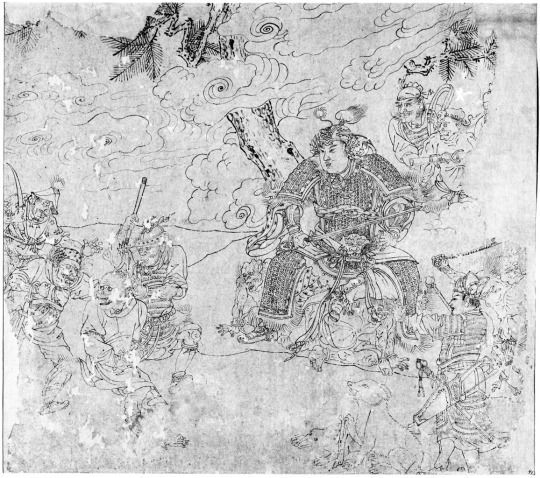
Erlang was connected to the JTTW story cycle at some point, leading to a late-Yuan or early-Ming zaju play called The God Erlang Captures the Great Sage Equaling Heaven (二郎神鎖齊天大聖). In addition, The Precious Scroll of Erlang (二郎寳卷, 1562), a holy text that predates the 1592 JTTW by decades, states that the deity defeats Monkey and tosses him under Tai Mountain. So it doesn't matter how equal their battle starts off in JTTW, or that other deities join the fray, Erlang ultimately wins because that is what history and religion expects him to do. And as I previously mentioned, Erlang has royal patronage. This means he was considered an established god in dynastic China. Sun Wukong, on the other hand, never received this badge of legitimacy. This was no doubt because he's famous for rebelling against the Jade Emperor, the highest authority. No human monarch in their right mind would publicly support that. Therefore, you can look at the Erlang-Sun Wukong confrontation as an established deity submitting a demon.
I'm sad to say that my acquaintance immediately ignored everything I said and continued debating the subject based on the standard narrative. That's when I left the conversation. It's clear that they don't respect the novel; it's nothing more than fodder for battleboarding.
I understand their mindset, though. I love Sun Wukong more than just about anyone. I too once believed that he was the toughest, the strongest, and the fastest. But learning more about the novel and its multifaceted influences has opened my eyes. I now have a deeper appreciation for Monkey and his character arc. Sure, he's a badass, but he's not an omnipotent deity in the story. There is a reason that the Buddha so easily defeats him.
In closing, please remember that JTTW did not develop in a vacuum. It may be widely viewed around the world as "fiction," but it's more of a cultural encyclopedia of history, folklore, and religious mythology. Realizing this and learning more about it ultimately helps explain why certain things happen in the tale.
#sun wukong#monkey king#journey to the west#jttw#Erlang#Erlang shen#Buddhism#Taoism#Chinese mythology#Chinese religion
374 notes
·
View notes
Text


Sleeping Satyr(Sátiro Adormecido), c.220 BCE Glyptothek Museum of Greek and Roman Sculptures, Munich
#dark academia#dark aesthetic#dark acadamia aesthetic#grunge#book quotes#books#coffee#poets on tumblr#academia#books & libraries#mythologie#norse mythology#celtic mythology#mythological#mythology greek
995 notes
·
View notes
Text
Archaeological and literary evidence indicate that knots were used in China as a method of keeping records, especially to assist in governance.[7][8] The practice had some similarities to the Incan practice of quipu.[9] Several works of classical Chinese literature make reference to it. The Tao Te Ching (ca. 400 BCE) alludes to the practice in chapter 80. As translated by Wing-tsit Chan:[10]
"Let the people again knot cords and use them (in place of writing)" [使民復結繩而用之]
The Yi Jing, Xi Ci II (ca. 168 BCE[11]), describes the practice:[12]
"In the highest antiquity, government was carried on successfully by the use of knotted cords (to preserve the memory of things). In subsequent ages the sages substituted for these written characters and bonds. By means of these (the doings of) all the officers could be regulated, and (the affairs of) all the people accurately examined."
The Eastern Han (25–220 CE) scholar Zheng Xuan, who annotated the Yi Jing, wrote that:[13][5]: 9 [clarification needed]
"Big events were recorded with complicated knots, and small events were recorded with simple knots." [事大,大结其绳;事小,小结其绳].
The chapter of Tubo (Tibet) in the New Book of Tang says:[14]
"The government makes the agreement by tie cords due to lack of characters." [其吏治,无文字,结绳齿木为约].
32 notes
·
View notes
Text

Scaled farm model, China, Han dynasty, 206 BCE–220 CE
33 notes
·
View notes
Text

Tianlong 天龍 "Heavenly Dragon" Talon Abraxas
Among Chinese classic texts, tian "heaven" and long "dragon" were first used together in Zhou Dynasty (1122 BCE – 256 BCE) writings, but the word tianlong was not recorded until the Han Dynasty (207 BCE – 220 CE).
The ancient Yijing "Book of Changes" exemplifies using tian "heaven" and long "dragon" together. Qian 乾 "The Creative", the first hexagram, says:
九五,飞龙在天,利见大人 Nine (it stands for a solid horizontal line that symbolizes the yang. Why nine is used is unclear.) in the fifth place means: Flying dragons in the heavens. It furthers one to see the great man. — Qian 乾 "The Creative", Yijing
41 notes
·
View notes
Text
As much as Reader Inserts are fun? Reminder that Ancient Rome was literally one of the MOST DIVERSE empires in human history. They also didn't consider themselves "white" per the modern post colonial and post chattel slavery definitions.
So I'm really sick and tired of all these Reader Insert fics for Gladiator II where Reader is so obviously coded as "white." With pale skin, pale eyes, light hair, rosy cheeked and where blushing and bruising can be easily seen.
The Roman empire stretched from the Atlantic Ocean to the Middle East and from all the way north to Britain and the borders of modern Germany to south through Northern Africa and where Sub-Saharan Africans existed. It contained tens of millions of people. The city of Rome hit a population of a million people around 133 BCE, which is nearly 300 years before the movie is set. And yes, wealthy Romans were POC too.
Not to mention, Rome had trade relations with India and loved Chinese produced silk. Ancient Roman coins, medallions and glass beads dating back to Marcus Aurelius himself have been found in China, Vietnam and Japan. Roman silverware and glassware have been found in China dating to the Han period of 202 BCE to 220 CE.
Y'all need to do some research and stop being so passively racist cause you want to write stories about fucking Daddy Pedro and your fave in Paul. Like, WTF? Be fucking better, Tumblr 🙄


#lucius verus#marcus acacius#pedro pascal#paul mescal#gladiator II#gladiator 2#gladiator#gladiator movie#gladiator ii#general acacius#pedro pascal gladiator#hanno#paul mescal gladiator#fandom racism#tumblr fail#racism in fandom
21 notes
·
View notes
Text
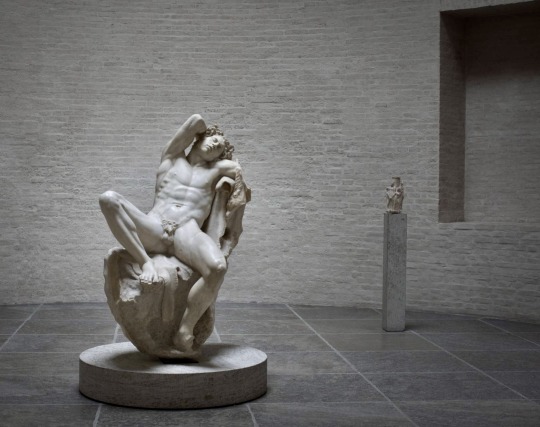
Barberini Faun, 220 BCE - Glyptothek - Munich, Germany
34 notes
·
View notes